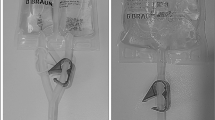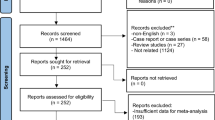Abstract
Study design:
Case report.
Objective:
To describe a case of severe hypotension and occasional syncope following intermittent catheterisations in a tetraplegic patient.
Setting:
Department of Spinal Injuries, Berck, France.
Case report:
A 47-year-old man presenting with C7 ASIA B tetraplegia for 9 months, developed episodes of severe hypotension and occasional syncope following intermittent catheterisations. These episodes were observed in the minutes following the catheterisations performed in the sitting position, associating hypotension and bradycardia. He was on intermittent catheterisation, had a history of bladder hyper-reflexia with some episodes of symptomatic urinary tract infections, of mild autonomic dysreflexia (headache, sweating) on high bladder distension, of mild orthostatic hypotension, and of reactional depression to the trauma, treated with fluoxetine hydrochloride (Prozac®).
Results:
The progressive removal of the fluoxetine hydrochloride (Prozac®) led to disappearance of the syncope 1 week later. Mild hypotension after catheterisations still persisted though, but completely disappeared a few months later after further management of bladder hyper-reflexia with botulinum-A toxin injections into the detrusor.
Conclusion:
In spinal cord injury patients at risk of micturition syncope, care should be taken to achieve a gradual decrease in bladder volume, to control bladder hyper-reflexia and to avoid any medications with orthostatic hypotension's side effects.
Similar content being viewed by others
Introduction
Rapid decompression of the bladder by catheterisation following acute retention of urine has been associated with hypotension and haematuria in non-neurologic patients.1 It is common practice to use a ‘clamping’ technique to achieve a gradual decrease in bladder volume.2
Syncope is a common disorder that is potentially disabling and affects both young and old.3 Micturition syncope usually occurs in healthy men who arise from bed at night, during or immediately after voiding. It is more frequent in the standing position, and after ingestion of alcohol.4 Micturition syncope can be an isolated symptom in a healthy subject, but is frequently associated with other neurological causes, such as autonomic failure of primary (multiple system atrophy) or secondary (such as diabetes mellitus) aetiology3, 4, 5 but has not been described as such in spinal cord injury (SCI) men.
Case report
A 47-year-old man presenting with C7 ASIA B tetraplegia for 9 months, developed episodes of severe hypotension and occasional syncope following intermittent catheterisations. These episodes were observed in the minutes following the catheterisations performed in the sitting position, associating hypotension and bradycardia.
He had a history of:
-
bladder hyper-reflexia treated with Oxybutynin chloride (Ditropan®) and intermittent catheterisation (five times a day); some episodes of symptomatic urinary tract infections;
-
mild autonomic dysreflexia (headache, sweating) on high bladder distension;
-
mild orthostatic hypotension treated with thigh elastic stockings and abdominal binding;
-
reactional depression to the trauma, treated with fluoxetine hydrochloride (Prozac®).
Anticholinergic drugs for bladder hyper-reflexia were raised, abdominal binding and elastic stockings were readjusted, to no avail. The progressive removal of the fluoxetine hydrochloride (Prozac®) led to disappearance of the syncope 1 week later. Mild hypotension after catheterisations still persisted though, but completely disappeared a few months later after further management of bladder hyper-reflexia with botulinum-A toxin injections into the detrusor.6
Discussion
Syncope is a transient loss of consciousness resulting from an insufficient supply of oxygen to the brain. It occurs when cerebral blood flow falls to below about half the normal value. Blood pressure is regulated mainly by baroreceptors reflexes by their control of vascular resistance and heart rate. The ability to vasoconstrict powerfully is important in resisting syncope; heart rate responses are of much less physiological importance.7
Low arterial blood pressure and decreased vascular resistance can be found in case of low cardiac output due to inadequate venous return, or in case of low total peripheral vascular resistance, due in particular to autonomic neuropathies, reflex causes or vasodilator drugs. These factors are likely to summate.7
Autonomic impairment is seen in many SCI patients: the sympathetic outflow of the baroreceptors to the peripheral vessels is impaired. This results in a decreased capacity to regulate vascular tone and, consequently, a decreased capacity to redistribute blood by means of vasodilatation or vasoconstriction.8 The inability to increase sympathetic outflow in SCI patients leads to venous pooling and low arterial blood pressure.
Relief of bladder distension may cause reflex vasodilatation and mild hypotension as the result of reduced stimulus to bladder stretch receptors.5, 9 This phenomenon can be more pronounced in SCI patients at T6 level and above, as the systolic blood pressure is often increased when the bladder is distended or contracts, as part of autonomic dysreflexia.10 The subsequent fall of blood pressure is then even more dramatic.
Orthostatic hypotension is a side effect associated with many medications such as antidepressant treatments (tricyclic and selective serotonin reuptake inhibitors). Some SCI patients are on such medications because of reactional depression. Hypotension can also be found if the individual has already been given pharmacological agents to decrease blood pressure, in case of autonomic dysreflexia for instance.
In our tetraplegic patient, cardiovascular autonomic dysfunction with autonomic dysreflexia and orthostatic hypotension together with a vasodilator drug such as fluoxetine hydrochloride (Prozac®) predisposed him to syncope. By progressive removing the Prozac® and inducing bladder areflexia with botulinum-A toxin injections into the detrusor, we were able to regulate two factors that significantly aggravated autonomic impairment and led to fall in arterial blood pressure and syncope.
Conclusion
In SCI patients at risk of micturition syncope, care should be taken to achieve a gradual decrease in bladder volume using a ‘clamping’ technique. Vasodilator drugs with orthostatic hypotension's side effects should be avoided. Finally, autonomic dysreflexia should be prevented by optimal management of bladder hyper-reflexia.
References
Nyman MA, Schwenk NM, Silverstein MD . Management of urinary retention: rapid versus gradual decompression and risk of complications. Mayo Clin Proc 1997; 72: 951–956.
Perry A, Maharaj D, Ramdass MJ, Naraynsingh V . Slow decompression of the bladder using an intravenous giving set. Int J Clin Pract 2002; 56: 619.
Mathias CJ, Deguchi K, Schatz I . Observations on recurrent syncope and presyncope in 641 patients. Lancet 2001; 357: 348–353.
Schiavone A et al. Micturition syncopes. Funct Neurol 1991; 6: 305–308.
Uchiyama T, Sakakibara R, Asahina M, Yamanishi T, Hattori T . Post-micturitional hypotension in patients with multiple system atrophy. J Neurol Neurosurg Psychiatr 2005; 76: 186–190.
Schurch B, Stohrer M, Kramer G, Schmid DM, Gaul G, Hauri D . Botulinum-A toxin for treating detrusor hyperreflexia in spinal cord injured patients: a new alternative to anticholinergic drugs? Preliminary results. J Urol 2000; 164: 692–697.
Hainsworth R . Pathophysiology of syncope. Clin Auton Res 2004; 14 (Suppl 1): 18–24.
Krebs M, Ragnarrson KT, Tuckman J . Orthostatic vasomotor response in spinal man. Paraplegia 1983; 21: 72–80.
Mary DA . The urinary bladder and cardiovascular reflexes. Int J Cardiol 1989; 23: 11–17.
Guttmann L, Whitteridge D . Effects of bladder distension on autonomic mechanisms after spinal cord injuries. Brain 1947; 70: 361–404.
Author information
Authors and Affiliations
Rights and permissions
About this article
Cite this article
Previnaire, J., Soler, J. Micturition syncope following intermittent catheterisation in a tetraplegic patient. Spinal Cord 44, 695–696 (2006). https://doi.org/10.1038/sj.sc.3101907
Published:
Issue Date:
DOI: https://doi.org/10.1038/sj.sc.3101907



